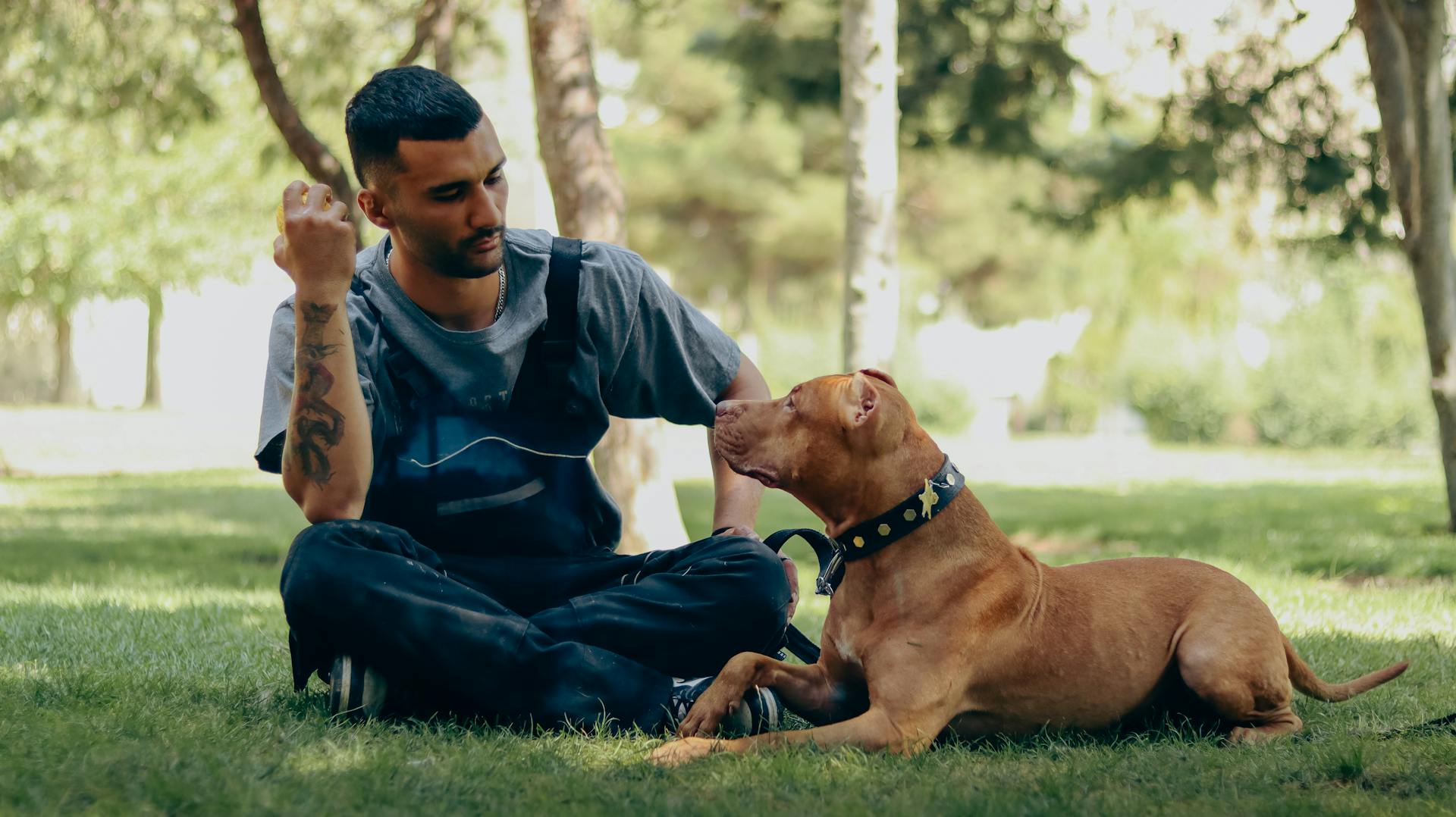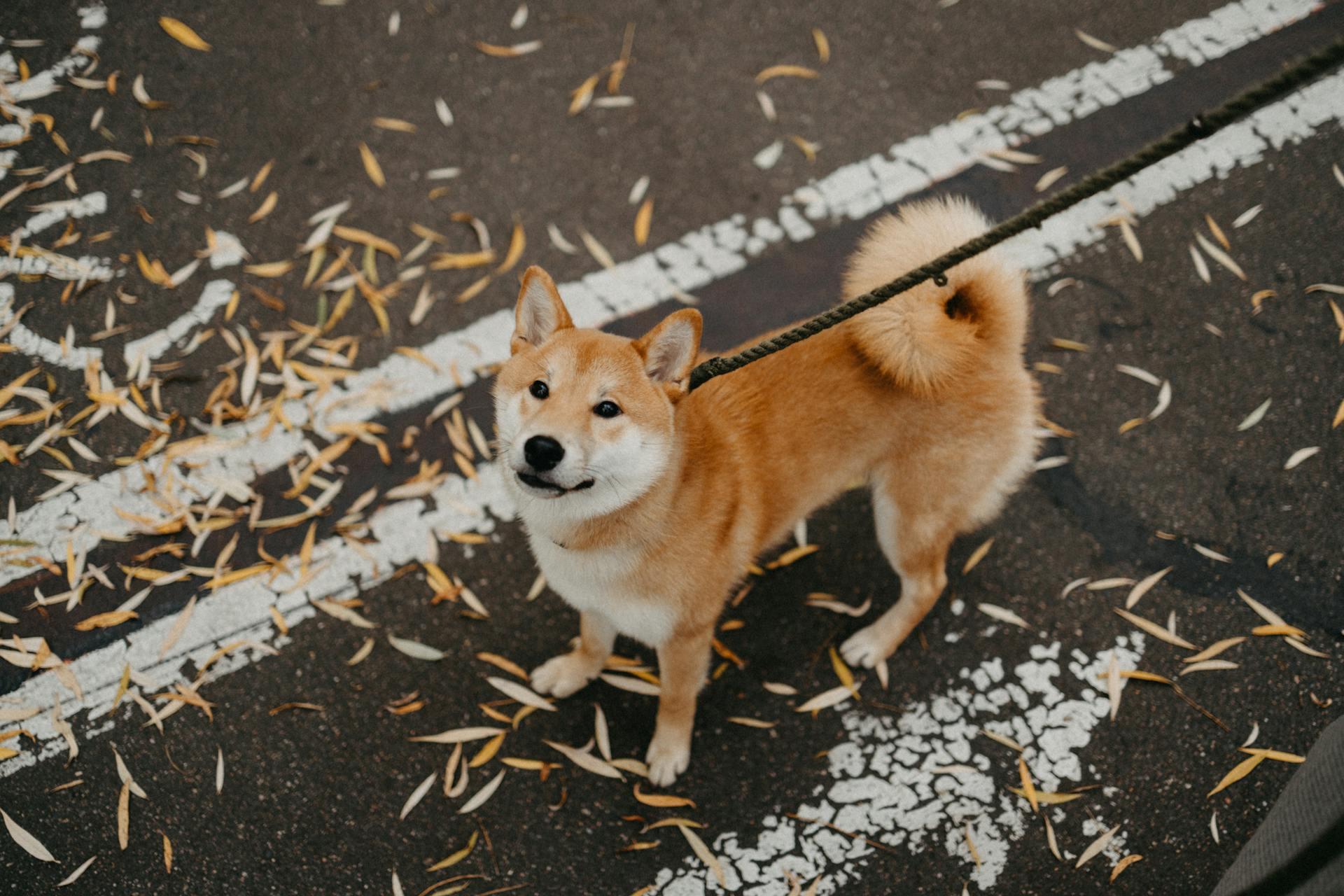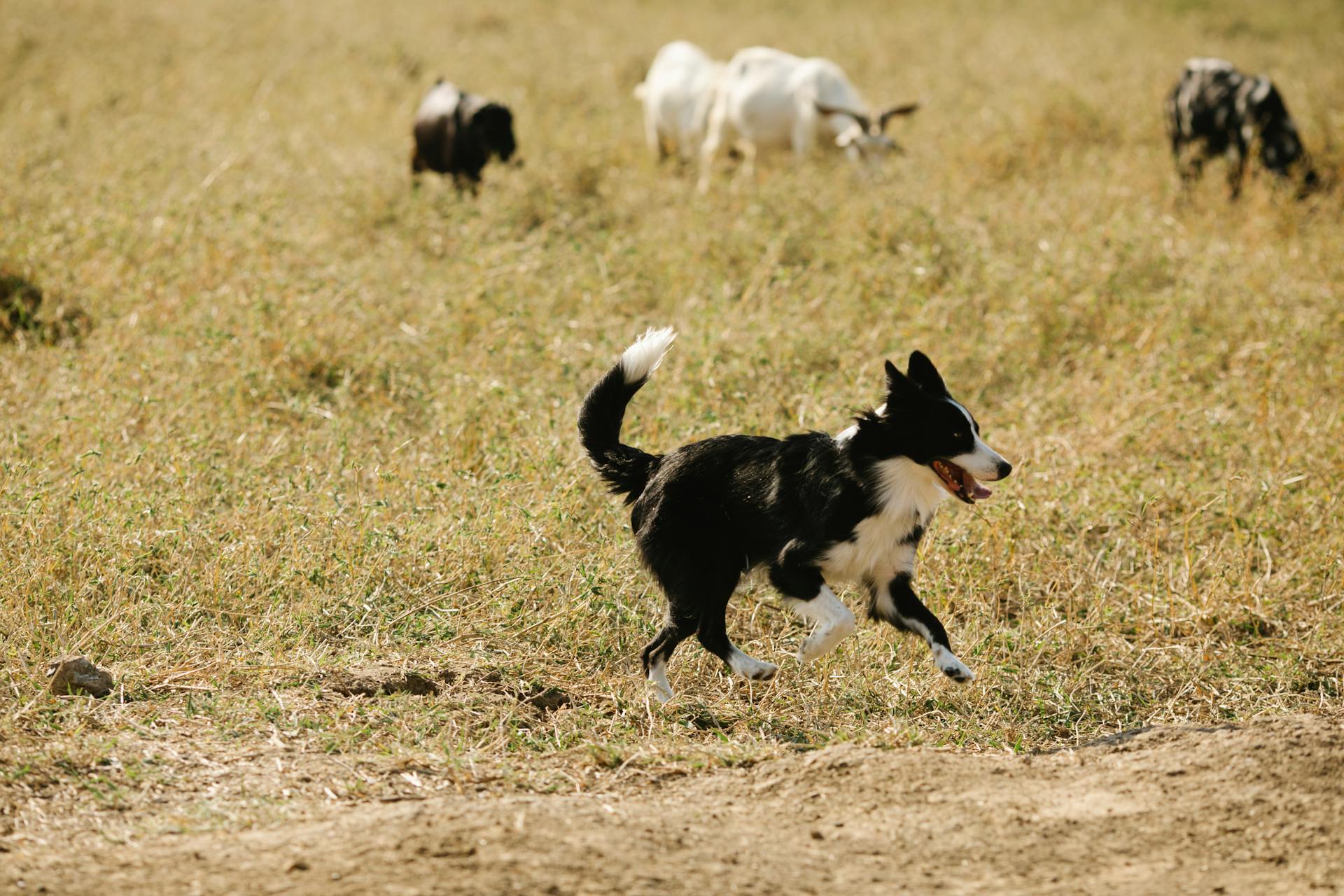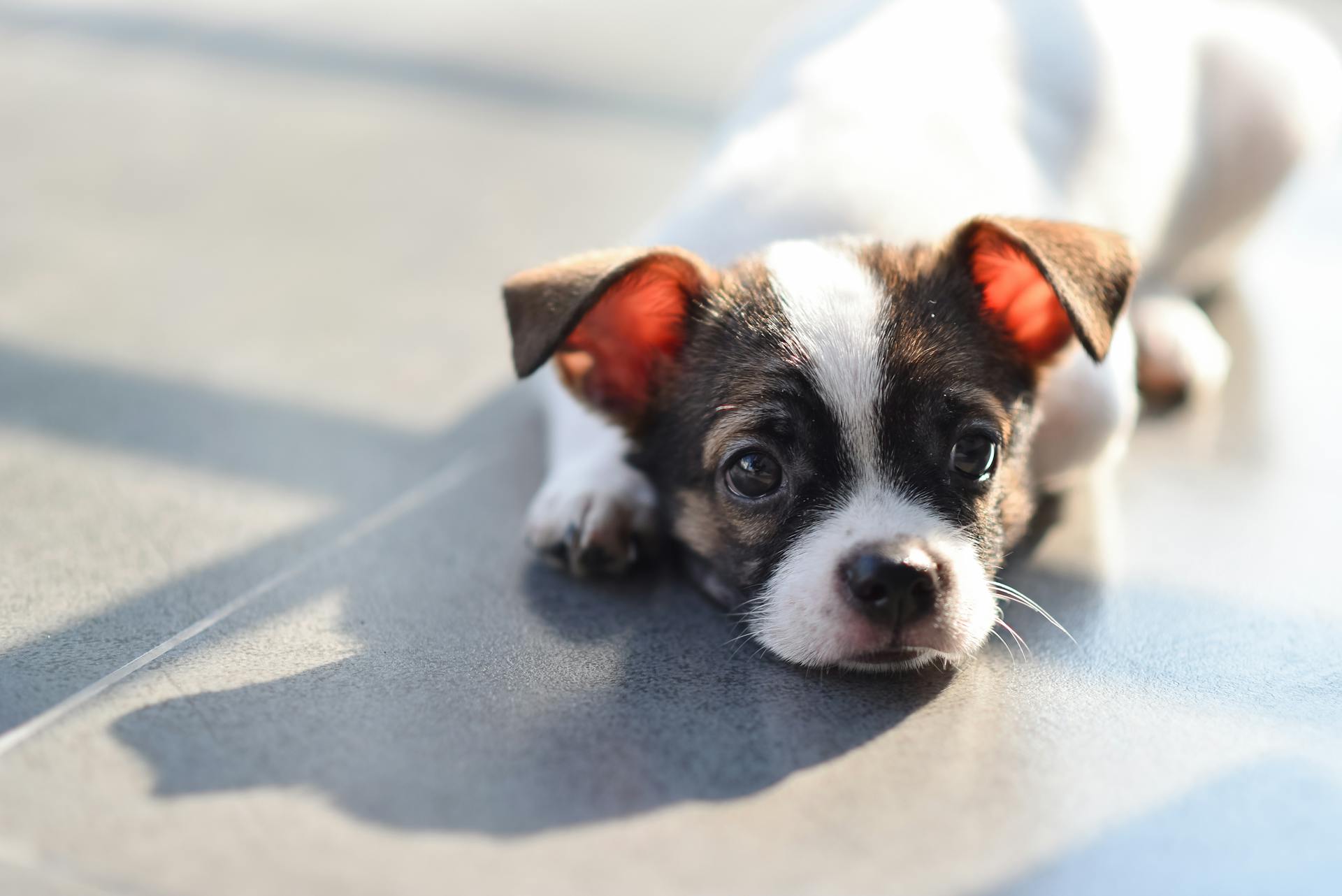
Pit bulls were originally bred for bloodsports like bull-baiting and bear-baiting in England. Their ancestors, the Old English Bulldogs, were specifically bred for this purpose.
In the 19th century, pit bulls were also used for dog fighting, which was a popular form of entertainment in England and the United States.
Pit bulls were bred to have a unique combination of characteristics that made them well-suited for these activities. They have a muscular build, a broad chest, and a short, easy-to-maintain coat.
Their short coats also made them easier to care for in the rough conditions of the bloodsports arena.
History and Origins
Pit bulls were originally bred in 19th-century England, Scotland, and Ireland from bulldog and terrier ancestry for hunting.
These early pit bulls were bred to combine the gameness of the terrier with the strength and athleticism of the bulldog, resulting in a dog that was well-suited for bloodsports like bull baiting and bear baiting.
Additional reading: English Bulldog Ancestry
Bull baiting and bear baiting were banned in Britain in 1835, but dog fighting continued clandestinely in small areas of Britain. This practice was later brought to America around 1845 to 1860.
In the late 19th century, the United Kennel Club (UKC) recognized the breed as the American Pit Bull Terrier in 1898.
The breed was initially recognized under the name "American (Pit) Bull Terrier" with the word "pit" in parentheses, but this was later dropped to simply "American Pit Bull Terrier".
Here's a brief overview of the breed's history:
The early 20th century saw pit bulls being used for various purposes, including as catch dogs for semi-wild cattle and hogs, to hunt hogs, and drive livestock, and as family companions.
The breed's versatility and strength made it a popular choice for many tasks, but its reputation as a fighting dog has also led to controversy and stigma.
In an effort to counter this reputation, some organizations have attempted to rebrand the breed under different names, such as "St. Francis Terriers" and "New Yorkies", but these efforts have largely been unsuccessful.
Today, the breed remains a topic of debate and discussion, with some people viewing it as a beloved companion animal and others seeing it as a symbol of aggression and danger.
Consider reading: Ukc Apbt
Breed Definition and Characteristics
Pit bulls are a type of fighting dog developed in 19th-century England, Scotland, and Ireland from bulldog and terrier ancestry for hunting.
Their origins are rooted in the British Isles, where they were bred for specific tasks. Pit bulls are also known as American Pit Bull Terriers, and other organizations recognize them as a distinct breed.
Here are some key characteristics of pit bulls:
Pit Bull Definition
The term "pit bull" can be a bit confusing, but essentially, it refers to a type of dog that originated in 19th-century England, Scotland, and Ireland from bulldog and terrier ancestry for hunting.
The American Kennel Club (AKC) doesn't recognize pit bulls as a distinct breed, but other organizations do. In fact, the AKC has a separate breed called the American Staffordshire Terrier, which some people consider to be the same breed as the pit bull.
The pit bull breed has a rich history, and its name has evolved over time. The name "pit bull" is often associated with dogfighting arenas, but it's worth noting that the breed has also been used in the motion-picture industry and has even been known to have musical talents.
Suggestion: Biggest Breed of Pit Bulls
The pit bull breed comes in a range of sizes, with a height at the withers of 17-21 inches (43-53 cm) and a weight of 30-60 pounds (14-27 kg). They have a life span of 12-16 years.
Here are some other names for the pit bull breed:
- American Pit Bull Terrier
- Pit Bull Terrier
- Pittie
This breed has been used in various roles, from hunting to companionship, and has been featured in popular culture in various ways.
Temperament
Pit bulls are known to be dogs of extremes, which can make them either ideal companions or a concern due to their potential aggression.
They are generally playful, willing to please, and moderately active, making them fun and obedient dogs that love to play games, especially challenging and physical ones.
Pit bulls are also generally quiet in the house and are not prolific barkers, making them a great choice for those who value a peaceful living environment.
As fair watchdogs and protectors, they can be effective in alerting their owners to potential threats.
However, their history as fighting dogs can lead to altercations with other dogs and sometimes with people.
In fact, pit bulls and pit bull mixes are responsible for more human and canine fatalities and severe trauma than all other breeds and mixes combined.
Their jaw and body strength can result in severe injuries or even death, which is a serious consideration for any potential owner.
Proponents of the breed believe that a pit bull's behavior depends on how it is raised, and that their temperament scores are similar to those of friendly breeds like Golden Retrievers.
Old Family Red Nose
The Old Family Red Nose is an old strain of American Pit Bull Terrier originating in Ireland, characterized by its unique reddish coloration, including a copper-red nose, red lips, red toe nails, and red or amber eyes.
This strain was known as "Irish Old Family Reds" due to the recessive nature of the red color, which is only visible when a dog has a high percentage of the recognized bloodlines of this family in its pedigree.
For more insights, see: Old English Sheepdog Origin
The Old Family Reds were highly sought after for their gameness and were bred to maintain their unique reddish color. Many reputable breeders, such as Lightner and McClintock, contributed to the preservation and development of the strain.
Not every red-nosed dog is a true Old Family Red Nose, as many strains have been crossed with the Old Family Reds at some point in their existence, resulting in occasional red-nosed pups.
Here's an interesting read: Are Pit Bulls Good Family Dogs
Pit Bull Breeds and Bloodlines
The American Pit Bull Terrier (APBT) has several bloodlines, many of which originated in "professional" dog fighting throughout the 20th century.
The Colby dogs are an ancient black-nosed bloodline that served as one of the pillars of the APBT breed. They were started by John Pritchard Colby in 1889, who acquired the best fighting dogs (bull and terriers) imported from Ireland and England.
One of the most famous dogs of the Colby bloodline was Colby's Pincher, who was widely used as a stud dog. Pincher is present in the pedigree of the vast majority of APBT specimens.
The APBT bloodlines can be categorized into several types, including Terriers, Working breeds, Bull-type breeds, and Toy breeds.
Here's a breakdown of the APBT bloodlines:
These bloodlines have played a significant role in shaping the APBT breed, but it's essential to prioritize responsible breeding practices and the well-being of individual dogs.
Pit Bull in American Culture
Pit Bulls have been a part of American culture for over a century, with their popularity as a family pet and working dog on the rise during the late 19th and early 20th centuries.
The breed's versatility and loyalty made them a favorite among families, farmers, and even police departments, who used them for tasks like herding and searching for fugitives.
Pit Bulls were often depicted in media and advertising as a symbol of strength, loyalty, and protection, which further solidified their place in American culture.
Their association with the working class and their ability to thrive in urban environments made them a staple in many American cities, where they were often found in tenements and apartments.
The breed's popularity as a family pet was also fueled by their gentle nature and affectionate personality, which made them a great companion for children.
Activities
Pit Bulls are naturally talented in dog sports like weight pulling, dog agility, flyball, lure coursing, and advanced obedience competition. They're often a top contender in these events, with 34 American Pit Bull Terriers and 13 American Staffordshire Terriers earning "superdog" status in the UKC.
Their intelligence, high energy, and endurance make them suitable for a wide range of working disciplines. They've been used as search and rescue dogs, police dogs, and Border Patrol dogs.
In the United States, Pit Bulls have also been used as hearing dogs to provide services to the deaf. They make excellent therapy dogs, offering comfort and companionship to those in need.
They're often a favorite dog for catching feral pigs, but this practice can be hazardous for the hunting dogs, who may experience severe injuries, heat exhaustion, poisoning, vehicular trauma, snake bites, or accidental shooting.
For another approach, see: How Often Do Pit Bulls Attack
Frequently Asked Questions
What two breeds make a pitbull?
Pitbulls descend from the British Bull and Terrier, a breed developed from crosses between the Old English Bulldog and the Old English Terrier. These two breeds are the foundation of the pitbull's ancestry.
Were Pit Bulls originally bred to protect children?
No, Pit Bulls were originally bred as guard dogs to protect farm animals, not specifically to protect children. Their early role was to guard and hunt, not to serve as child caregivers.
Sources
- https://www.thehumanesociety.org/debunking-pit-bull-myths/
- https://love-a-bull.org/resources/the-history-of-pit-bulls/
- https://www.britannica.com/animal/pit-bull
- https://www.npr.org/2016/05/10/477350069/friend-or-fiend-pit-bull-explores-the-history-of-americas-most-feared-dog
- https://en.wikipedia.org/wiki/American_Pit_Bull_Terrier
Featured Images: pexels.com


